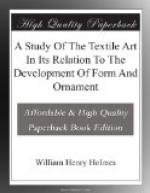Non-essential constructive features.—Now, all the varied effects of color and design described in the preceding paragraphs are obtained without seriously modifying the simple necessary construction, without resorting to the multiple extraordinary devices within easy reach. The development and utilization of the latter class of resources must now receive attention. In the preceding examples, when it was desired to begin a figure in color the normal ground filament was dropped out and a colored one set into its place and made to fill its office while it remained; but we find that in many classes of work the colored elements were added to the essential parts, not substituted for them, although they are usually of use in perfecting the fabric by adding to serviceability as well as to beauty. This is illustrated, for example, by the doubling of one series or of both warp and woof, by the introduction of pile, by wrapping filaments with strands of other colors, or by twisting in feathers. Savage nations in all parts of the world are acquainted with devices of this class and employ them with great freedom. The effects produced often correspond closely to needlework, and the materials employed are often identical in both varieties of execution.
The following examples will serve to illustrate my meaning. The effect seen in Fig. 330 is observed in a small hand wallet obtained in Mexico. The fillets employed appear to be wide, flattened straws of varied colors. In order to avoid the monotony of a plain checker certain of the light fillets are wrapped with thin fillets of dark tint in such a way that when woven the dark color appears in small squares placed diagonally with the fundamental checkers. Additional effects are produced by covering certain portions of the filaments with straws of distinct color, all being woven in with the fabric. By other devices certain parts of the fillets are made to stand out from the surface in sharp points and in ridges, forming geometric figures, either normal or added elements being employed. Another device is shown in Fig. 331. Here a pattern is secured by carrying dark fillets back and forth over the light colored fabric, catching them down at regular intervals during the process of weaving. Again, feathers and other embellishing media are woven in with the woof. Two interesting baskets procured from the Indians of the northwest coast are shown in Figs. 332 and 333. Feathers of brilliant hues are fixed to and woven in with certain of the woof strands, which are treated, in the execution of patterns, just as are ordinary colored threads, care being taken not to destroy the beauty of the feathers in the process. The richly colored feathers lying smoothly in one direction are made to represent various figures necessarily geometric. This simple work is much surpassed, however, by the marvelous feather ornamentation of the Mexicans and Peruvians, of which glowing accounts are given by historians and of which a few meager traces are found in tombs. Much of the feather work of all nations is of the nature of embroidery and will receive attention further on. A very clever device practiced by the northwest coast tribes consists in the use of two woof strands of contrasting colors, one or the other being made to appear on the surface, as the pattern demands.




